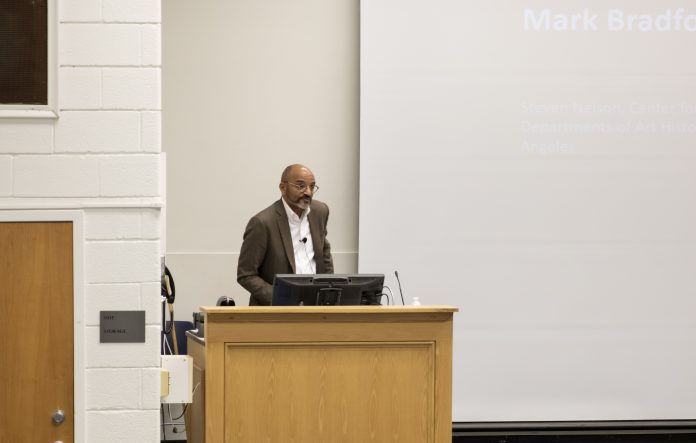Thursday, Feb. 6, Dr. Steven Nelson, a professor of African and African-American art at the University of California, Los Angeles, participated in art and art history department’s distinguished lecture series. The discussion began with an introduction given by department chair and associate professor of art history Sibel Zandi-Sayek. Zandi-Sayek gave Nelson a lengthy introduction, highlighting several of his academic honors and awards as well as his seasoned history and involvement in the art world.
“It is our honor to present distinguished speaker Dr. Steven Nelson, director of the African Studies Center and professor of African-American art history,” Zandi-Sayek said. “Dr. Nelson is currently the Andrew Mellon professor at the Center for Advanced Study for the Visual Arts at the National Gallery of Art in Washington, D.C.”
Nelson’s talk marked the ninth anniversary of the distinguished art lecture series. From the Lemon Project to the most recent renovation of the Muscarelle Museum of Art, the lecture series is run in pairing with funding by a late anonymous donor. It has previously hosted prominent scholars and artists who have shared their knowledge and expertise in their fields of study. The College of William and Mary has taken initiative to focus on its deep-rooted history in African-American arts.
Dr. Nelson was first trained at Yale University in studio art and received his M.A. and Ph.D. in art history at Harvard University. Nelson is also the author of award-winning book “From Cameroon to Paris: Mousgoum Architecture In and Out of Africa.” Nelson’s lecture was titled “Mark Bradford: Counterfeit Abstraction.”
Mark Bradford is a contemporary African-American artist based out of Los Angeles, California. He is most famous for his grid-like paintings, often expressing sentiments of struggling integrity within the context of the world of counterfeit abstraction. The talk was given in part to his newest project, a book titled “Structural Adjustments: Mapping, Geography, and the Visual Cultures of Blackness.”
After thanking Zandi-Sayek for her warm introduction, as well as the program for hosting him, Nelson began his conversation with a discussion of his upcoming book.
“‘Structural Adjustments: Mapping, Geography, and the Visual Cultures of Blackness’ honors the contemporary work of African and Afro-Atlantic artists; including Mark Bradford, Maria Magdalena Campos-Pons, Houston Conwill and Julie Mehretu, all of whom employ mapping and geography to address key concerns in their work,” Nelson said.
Nelson went on to discuss how all of the artists discuss and display notions of site, place and affiliation within African-American art and art history.
“These works have created a unique visual power and complexity that reshape our understanding of African ancestry, notions of diaspora and urban spaces,” Nelson said. “Maps have occupied a contemporary space in modern day art since at least the early 1960s.”
Some of the best-known works of abstract expressionism are those of Jasper Johns. The works of Johns are known to have caused reverberations that influenced the art world from the 1950s through the present. Johns centered his work ideas around what he described as “things the mind already knows.” He utilized realistic items such as signs and flags which he claimed represented perceptual ambiguity.
“Afro-Atlantic artists used their work to show their newfound love for their lands,” Nelson said. “Sometimes, they used it to critique the ungrounded institutions known as American prisons.”
The talk covered uses of various artistic mediums. Nelson consistently discussed the use of maps in art and how they define an artist’s sense of belonging in a community and its members. While for some maps pay tribute to their homes, others have used the medium as a way to express and mindful sense of belonging.
Nelson used his lecture as a ground to begin discussion of race and the conceptual ideology of belonging in a community. The talk sparked a frenzy of discussion immediately following its closure. Among those in the crowd was psychology major Caroline Rhodes ’21.
“I am not involved with the art world; however, my friend is, and that is why I came to this talk today,” Rhodes said. “The talk did really open my eyes and change my perspective quite a bit on the subject of self-expression. The way that these artists are expressing so many different sentiments and emotions just through maps is really neat and definitely something I will pay more attention to in the future.”
As the ninth lecture so far in the series, Nelson’s talk continued the mission of the art department to bring in more artists and scholars to highlight some of the greater injustices and underlying themes in the modern world using new mediums and means of expression.

